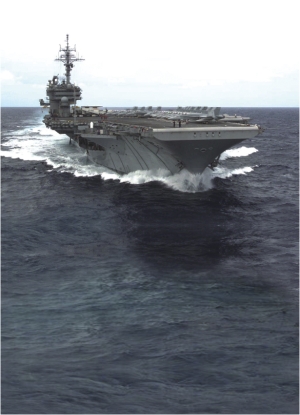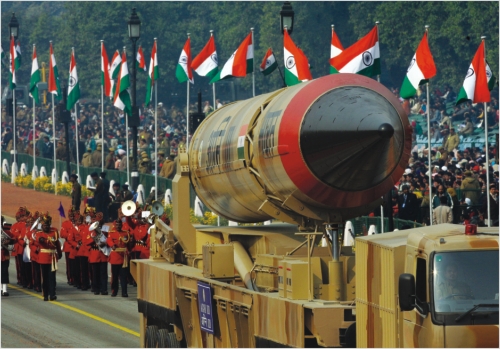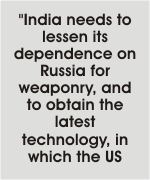
Inside
|
Kitty Hawk for India? Mir Mahfuz Rahman discusses the deepening military ties between India and the US The Kitty Hawk is the town in North Carolina where the Wright Brothers first powered airplane flight took place. It is also the name of the one of the largest naval ships in the world which has been the focus of an interesting shift in US foreign policy regarding South Asia.
For the uninitiated, an aircraft carrier is a warship designed with the primary mission of deploying and recovering aircraft, acting as a sea-going airbase. Aircraft carriers allow a naval force to project air power great distances without having to depend on local bases for staging aircraft operations. The US has also made use of carriers in the Persian Gulf, Afghanistan, and to protect its interests in the Pacific. During the 2003 invasion of Iraq, US aircraftcarriers served as the primary base of US air power. Even without the ability to place significant numbers of aircraft in Middle Eastern airbases, the United States was capable of carrying out significant air attacks from carrier-based squadrons. At the same time, an aircraft carriers movements in peace time can show shifts in emphasis in foreign policy of countries. The news of the movement of one these giants into the Red Sea, Persian Gulf or the Indian Ocean can be scrutinised in detail by foreign policy mandarins. This watching is with good reason. An aircraft carrier of the US Navy is a behemoth, weighing almost 100,000 tons and carries almost 5,000 soldiers and sailors (an army division on land has about 10,000 soldiers). For those with a penchant for power, each aircraft carrier carries almost 90 planes, which is a bigger strike force than all but a few national air forces of the world, and are usually nuclear powered. The latter means that these ships never have to dock for fuel.
As a result, aircraft carriers are easily the largest ships operated by navies, with a Nimitz class supercarrier costing $5 billion to build, equipped with two nuclear reactors and four steam turbines for power -- not including the aircraft and weaponry required. The United States has the majority of aircraft carriers (and also the only country with supercarriers) with eleven in service, one under construction, and one on order. Its aircraft carriers are a cornerstone of American power projection capability. France's Charles de Gaulle is currently the only nuclear powered aircraft carrier operated by a country other than the United States.
On June 6, 1963, President John F. Kennedy, with top civilian and military leaders, boarded Kitty Hawk to witness a carrier task force weapons demonstration off the California coast. Addressing the men of the task group from Kitty Hawk, President Kennedy told them that, as in the past, control of the seas still means security, peace and ultimate victory. He later wrote to President and Madame Chiang Kai-Shek who had witnessed a similar demonstration on board USS Constellation: "I hope you were impressed as I was, on my visit to Kitty Hawk, with the great force for peace or war, which these mighty carriers and their accompanying escorts provide, helping to preserve the freedom of distant nations in all parts of the world." The Kitty Hawk of our interest was commissioned April 21, 1961 at Philadelphia Naval Shipyard. The reason for the interest in Kitty Hawk, and the lesson in supercarriers, is that the ship is meant for decommissioning in 2008. India desperately needs aircraft carriers, too, as its purchase of the Russian ship Admiral Gorshkov is delayed, and India's own carrier, the INS Viraat, is aging fast. For weeks, reports have circulated in Indian newspapers and on various blogs that the US would give the USS Kitty Hawk to India. This has however been hotly denied and remains a rumour.
India started the construction of a 37,500 tonne, 252 meter-long Vikrant class aircraft carrier in April 2005. The new carrier will cost $762 million and will operate MiG 29K "Fulcrum," Naval HAL Tejas and Sea Harrier aircraft along with the Indian-made helicopter HAL Dhruv. The ship will be powered by four turbine engines and when completed will have a range of 7,500 nautical miles (14,000 km), carrying 160 officers, 1,400 sailors, and 30 aircraft. The carrier is being constructed by a state-run shipyard in Cochin. It is well know that India bought Admiral Gorshkov from Russia for $1.5 billion, which is to be renamed the INS Vikramaditya, and was expected to join the Indian Navy in 2008 after a refit. However, this refitting has been delayed till 2011. However, this focuses our attention to an even more interesting point -- that of power projection by the undisputed economic power of South Asia. The trip by US Defense Secretary Robert Gates to India in February 2008 coincided with India's plan to improve its armed forces dramatically. New Delhi is expected to buy around $100 billion worth of equipment and technology including fighter aircraft and submarines over the next five years, replacing its outdated Russian arsenal. The fighter jets are the big purchase in play. Apart from the American F-16s and F-18s, Russia's MiG-35s are being aggressively marketed to the Indians. The Americans seem to be in the lead. In a separate purchase in early February, India agreed to buy six military transport planes worth $1 billion from Lockheed Martin (LMT). This time, both Lockheed and Boeing are vying to sell fighter jets to India. In an article in BusinessWeek, C. Uday Bhaskar, security analyst and former director of the New Delhi-based Institute for Defense Studies & Analysis, mentioned:"It is highly desirable for both the US and India to deepen their military ties. India needs to lessen its dependence on Russia for weaponry, and to obtain the latest technology, in which the US leads. It will take some time for the US to replace Russia as the premier arms supplier to India. But India is leaning increasingly towards Washington." The rise of corporate India is the sure platform on which the power projection is to be built. True to its domestic industrialization strategy, India privatised defense manufacturing and purchase so it could build up its own industry. New Delhi has stipulated that successful foreign bidders on weapons deals must reinvest 30% of the value of any contract worth more than $70 million in India-based manufacturing, so weapons technology and skills can develop at home. Consequently, foreign companies have been scanning the radar for suitable local partners. Tata Group has struck deals with Boeing for arms-related components and with Connecticut-based Sikorsky Aircraft, to establish an S-92 helicopter cabin production unit. Indian Defense Review says that by assigning stakes to "friends like the US, Germany, and France, India can leverage its stature in international forum. It's a win-win situation." To no one's surprise, India's power surge is aimed at Pakistan and China. In pure power projection terms, the Kitty Hawk rumour, and yes, it remains a rumour, is a reflection of the hard nature of the economic surge of our times. These subtle rumours and shifts in power capabilities, though not reported in the main stream press and obviously not tracked by most crowds, reveals the changing rules by which the great game is played. And these days, supercarriers with the threat of very real South Asian power projection have become part of the equation.
Mir Mahfuz Rahman, having studied economics and international relations at Johns Hopkins University, is a merchant banker and entrepreneur.
|


 While nine countries maintain a total of 21 aircraft carriers, only the US, UK, and Russia are real naval powers, with France, Italy, India, Spain, Brazil and China still in the learning stage. The United Kingdom and France are both undergoing a major expansion in carrier capability (with a common ship class), but the United States will still maintain a very large lead.
While nine countries maintain a total of 21 aircraft carriers, only the US, UK, and Russia are real naval powers, with France, Italy, India, Spain, Brazil and China still in the learning stage. The United Kingdom and France are both undergoing a major expansion in carrier capability (with a common ship class), but the United States will still maintain a very large lead. 

